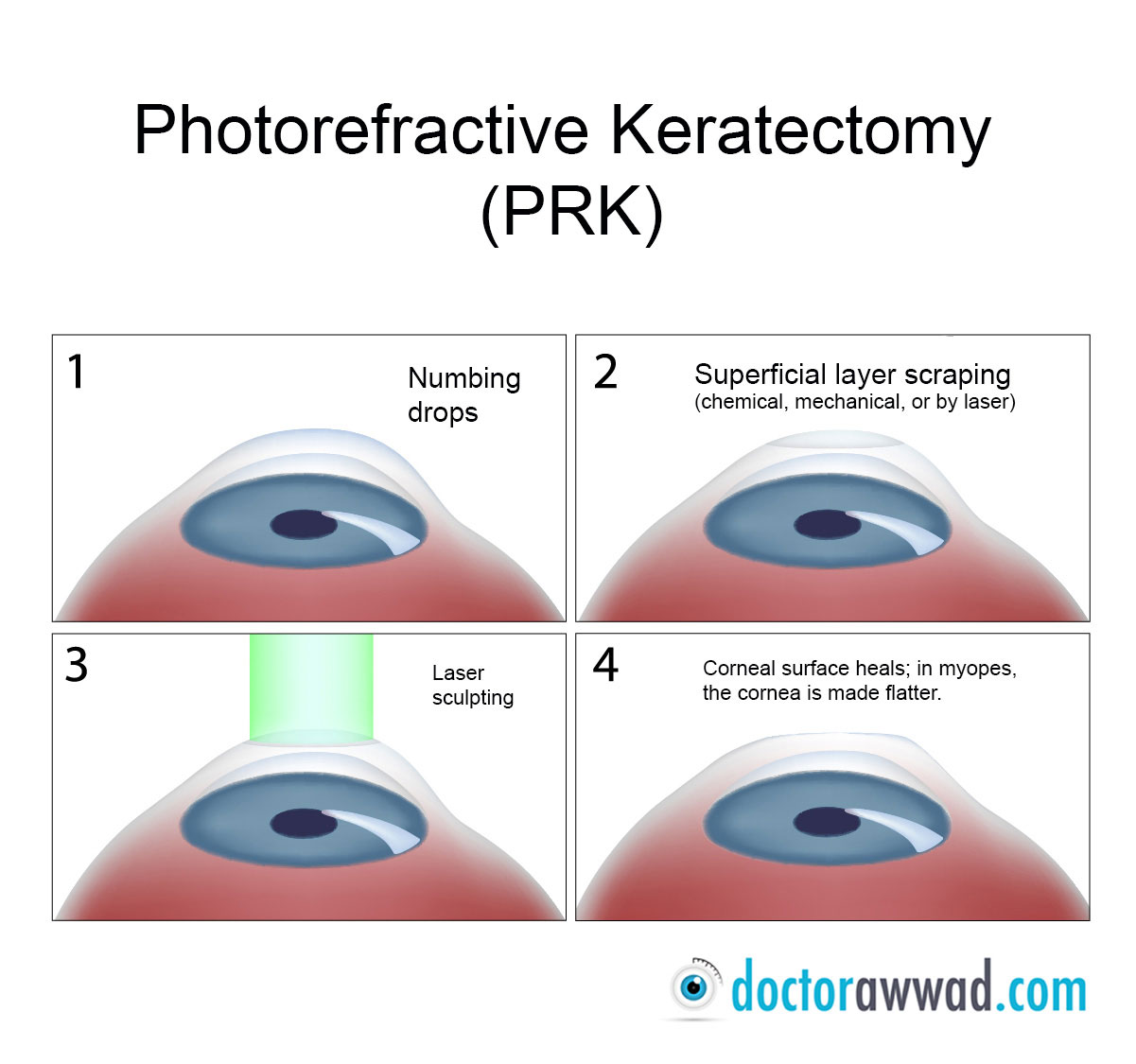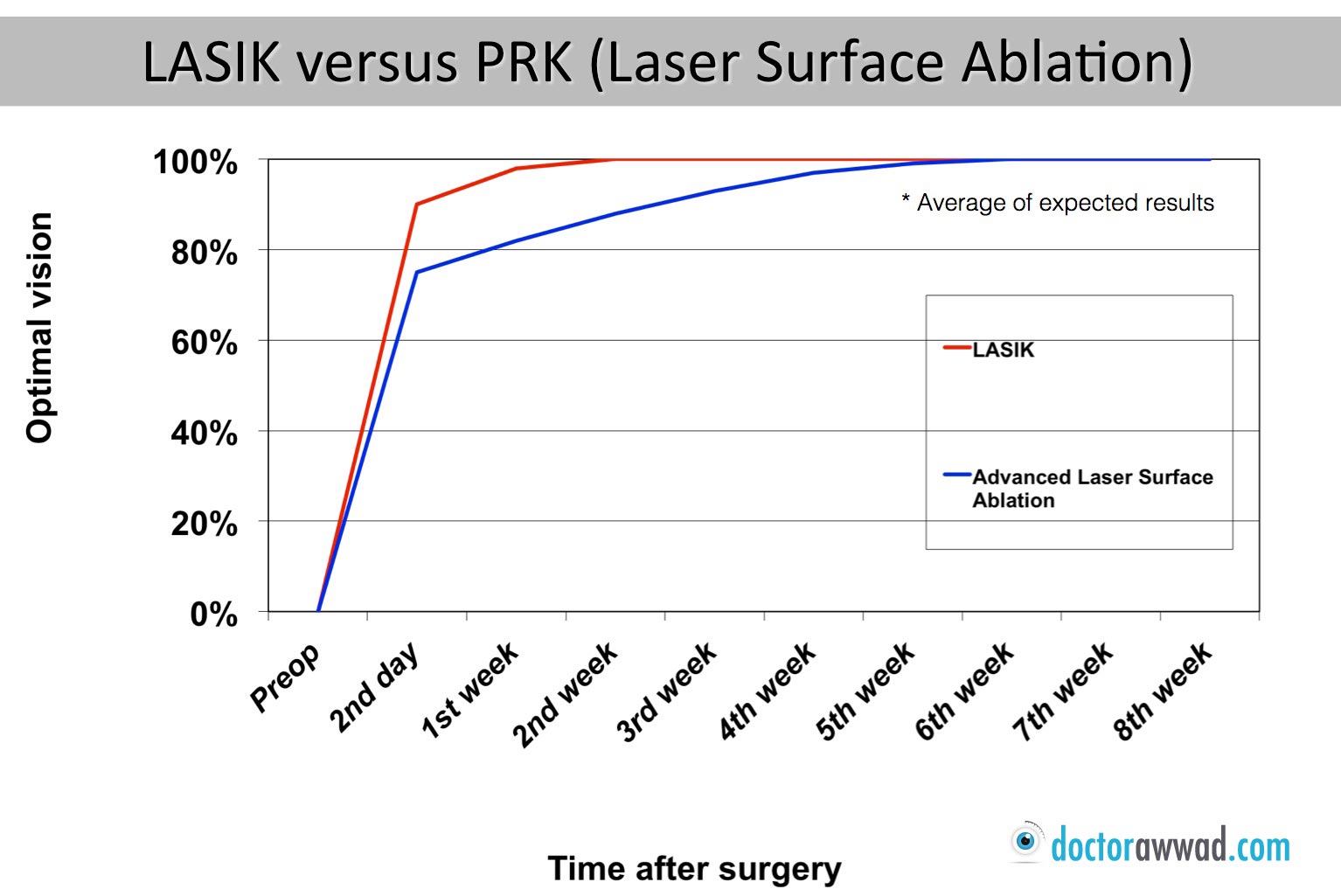Laser vision correction uses laser technology to sculpt the human cornea and reshape it so that the light entering the eye through it would get focused more accurately on the retina, a sensitive tissue lining the back of the eye. The retina conveys the information to the brain, which interprets the images we see. There are two major forms of laser vision correction: LASIK ( i.e. laser in-situ keratomileusis, or simply put, laser inside the cornea), and Laser Surface Ablation, where the laser is applied on the surface of the cornea.
[Video: LASIK vs. LASER Ablation ]
LASIK
With LASIK (LASER in situ keratomileusis, or very literally, LASER inside the cornea), a small flap is created in the front portion of the cornea with either a micromechanical device or a special laser system called femtosecond laser (currently the standard of care). The flap is then lifted and an excimer laser controlled by a computer is applied on the remaining cornea to sculpt a new shape, either decreasing the curvature of the cornea, to correct nearsightedness, or increasing the curvature of the cornea, to correct farsightedness. The reshaped cornea allows the light rays to focus more accurately on the retina. [view photos]
LASER Surface Ablation (PRK/TransPRK)
With PRK or laser surface ablation, the laser reshaping is applied on the surface of the cornea, without performing a flap or any cut. A computerized excimer laser is applied on the cornea to reshape it. A contact lens is then applied on the cornea to promote healing and improve comfort. The outer skin of cornea will regenerate, protected by the contact lens, within 3-4 days, after which the contact lens is removed. The reshaped cornea focuses light more accurately on the retina. [view photos]
Who is a candidate
Candidates for the procedure are patients who are older than 18 years of age, having a stable correction (no more than 0.5 D change in one year), having up to 12 diopters of myopia (recently most eye doctors prefer below 9 D), up to 6 diopters of astigmatism, and up to 6 diopters of hyperopia. For patients with presbyopia, or inability to read for near, LASIK might or might not help, depending on your eye exam; so a preliminary evaluation is mandatory.
Some patients are not good candidates, like patients with very thin corneas or some types of corneal diseases like keratoconus, patients with marked to severe dry eyes, patients diagnosed with cataracts or glaucoma, patients with certain health problems or on some chronic medications, and currently pregnant or nursing women. To know if you are a good candidate for the laser vision correction procedure, whether via LASIK or laser surface ablation, a complete eye exam is mandatory, whereby the ophthalmologist measures your refractive error and evaluates your eyes from front to back, and runs a computerized topography of your cornea to determine its shape and thickness. Your eye doctor will recommend the best procedure for you.
[Video: Preliminary Evaluation]
Alternatives
Patients who are not candidate for laser correction might be eligible for phakic lens implantation. This procedure corrects very high myopia, up to – 20 diopters, high hyperopia and astigmatism. A tiny incision is made in the eye, the implantable lens is then inserted through the incision and is unfolded inside the eye, then it is positioned in front of the eye’s natural lens, where it provides the needed correction to focus light more accurately on the retina.
Preliminary Evaluation
An initial evaluation should first be performed, whereby candidates for the procedure would undergo a complete eye exam, including pupil dilation, and corneal topography and thickness measurements. It is advised to stop wearing contact lenses at least 3 days before the evaluation. Accordingly, the ophthalmologist would gather information from the exam and the test results and would recommend which procedure suits you best. In preparation for surgery, contact lenses should be removed at least 3 days before the procedure, and sometimes up to one to two weeks, if your doctor judged necessary. Also, avoid wearing eye make-ups starting the day before the procedure.
The procedure
During either LASIK or LASER surface ablation procedure (PRK), you will be lying down at all time and looking up at the laser system positioned on top of your face. Anesthetic drop will be used to numb your eyes and make you totally comfortable throughout the procedure. A small clip or eyelid spreader will be inserted between your eyelids to prevent you from closing your eye. You will be asked to look at a green blinking light. When it’s time for the laser to work, you will be notified, and you should look at the blinking light at all times. The laser, however, will follow your eye in case it moves, and will completely stop if it moves far out. Once you look at the light again, the laser will continue exactly where it left off. Looking at the light, however, will ensure uninterrupted, smoother treatment. The procedure will take around 5 minutes per eye.
[Video: Before, during, & after LASIK/PRK]
After the procedure
After LASIK, you can resume normal activity like driving, reading, and computer work the second day of the surgery. You need to keep your sunglasses when out for one week. You will need to use lubrication drops as needed for several weeks to several months.”
After Laser Surface Ablation, you will experience blurry vision as well as episodic light sensitivity, burning, and tearing for up to 3 days. You should be able to drive and work on computers within 5-7 days. However, vision for near will be much more comfortable after 2 weeks of the procedure. Vision will keep improving with time and it reaches its peak in about 3-4 months on the average.
After either procedure, you need to avoid eye rubbing for one month and direct water contact to the eye for one week. Try to avoid directly splashing your eyes while washing your face or showering as much as possible for one week, and avoid swimming for 3-4 weeks. Additionally, no eye make-up should be applied till after 3 weeks. You will also be using antibiotics and anti-inflammatory drops 4-5 times a day and lubrication drops as needed, and they will be tapered and stopped according to your doctor’s instructions.
Problems & Solutions
You might temporarily experience dry eyes for a few weeks to several months. Symptoms include episodic foreign body sensation, and occasional blurry vision and visual fluctuation, especially while reading and during computer work. Using lubrication drops as needed should relieve the symptoms till the eyes get better. Rarely, some patients, especially those with high myopia, might experience some halos around lights or objects at night. These symptoms will improve in the vast majority over the course of several months. Rarely, some patients might need a customized LASIK or laser enhancement procedure to relieve the symptoms. Weakening of the cornea, or corneal ectasia, is a very rare complication that can induce visual errors. Fortunately, it can most often be prevented by a careful preoperative screening, and can be treated by different modalities. Flap complications in case of LASIK, like displacement, inflammation, and infection, are rare and can be successfully treated. They can be prevented by adhering to postoperative instructions and following-up with your doctor in the first few days. Corneal haze (scarring) in the case of PRK/TransPRK is a very rare, yet possible side effect which might be treated with medications and a specialized procedure.
As a summary, with LASIK, a small flap is created in the front portion of the cornea then laser is applied on the remaining cornea to sculpt a new shape, after which the flap is repositioned. With LASER surface ablation or PRK/TransPRK, the laser reshaping is applied on the surface of the cornea, without performing a flap or any cut. The eye surgeon may choose one over the other in a particular patient based on the results of the initial eye examination. LASIK may cause minimal discomfort the day of surgery, it provides fast visual recovery to around 90% vision right from the next day, as patients can drive and go back to work. Additional visual improvement occurs within a week or two. LASER Surface Ablation causes mild to moderate discomfort for up to 3 days after surgery, and has a slower visual recovery of 5 to 7 days before complete resumption of normal daily activity like driving and office work, with even more comfortable reading ability within 2 weeks. Further improvements keep developing over several months. When measured after 3-4 months, final vision and success rate are generally equal between the two procedures. Long-term results are also essentially the same. As a rough average, 97 % will be spectacle or eyeglasses free, meaning their error will be within +/- 0.5 diopter. Of the remaining, around 1-2 % of patients might need an enhancement procedure due to a residual error or a regression. A regression is when a small fraction of the error resurfaces after several months of successful treatment. A residual error is any error larger than ± 0.5 diopter remaining after treatment. Combined, regression and residual error develop in around 3 % of treated eyes as a rough average. Regression seldom develops after 6 months to 1 year. Hence visual results after surgery are considered stable after 6 months to 1 year. Your ophthalmologist will recommend to you the procedure that suits you best based on your initial evaluation and results of your eye tests. [view photos]



